Helping You Feel Comfortable in the Treatment Chair
Sedation dentistry makes dental care stress-free and comfortable. Stress is commonly associated with dental treatment. For many people, the level of fear and anxiety can be overwhelming. In our dental office, we offer a variety of sedation techniques including intravenous sedation, nitrous oxide (laughing gas), and oral conscious dental sedation to eliminate the anxiety of dental care.
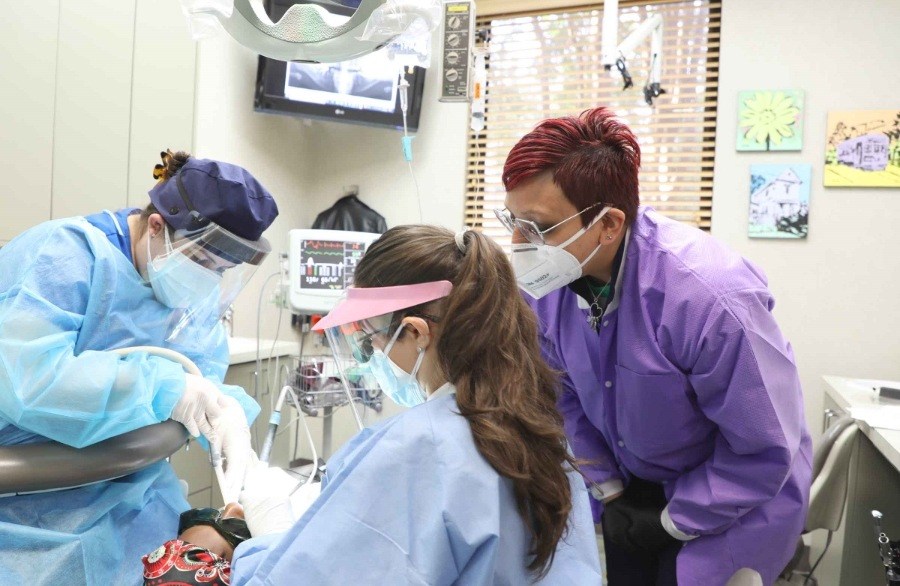
Have you been dealing with recurring sensitivity, dental pain, or swelling because of your fears? If so, you are not alone, and a visit with our sedation dentist may be the answer.
Why Choose Roman Dental for Sedation Dentistry?

Friendly, Understanding Dental Team

We Accept Dental Insurance

Safe, Calming Sedation Dentistry

Which Type of Sedation Dentistry Should I Get?
Sedation dentistry is used for all types of dental care. The method of sedation varies dependent upon the patient’s needs and the type of dental treatment being received. Some fearful patients simply require emotional reassurance along with strong local anesthesia. A comfortable experience for others might require nitrous oxide (laughing gas) or oral conscious sedation. For those who want to be totally unaware, Dr. Roman offers the benefits of IV sedation, sometimes called twilight sleep.
Nitrous Oxide Dental Sedation
Nitrous oxide is a gas that is inhaled through a mask placed over the nose. It is used for patients of all ages. Nitrous oxide is often combined with local anesthetics, pain, and anxiety medications. Nitrous oxide raises the pain threshold. For this reason, it makes dental anesthetic injections more comfortable. Additionally, nitrous oxide will make treatment time appear to pass more quickly. Nitrous oxide provides conscious sedation. This means that the patient is awake and able to answer questions but feels relaxed and comfortable. Nitrous oxide produces a feeling of euphoria and giddiness, earning it the name of laughing gas.
Laughing gas has a great advantage over other sedatives: it’s fast-acting, has few side effects, and rapid recovery time enables patients to safely drive a vehicle after treatment.
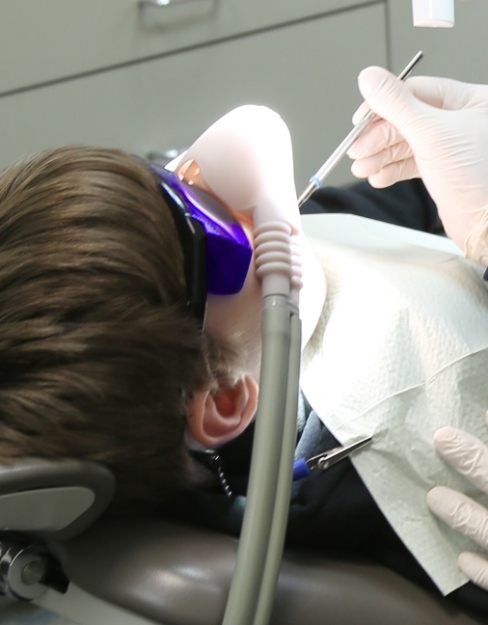
Once your dental treatment is completed, 100 % oxygen is breathed-in, removing all traces of nitrous oxide from the body and providing an additional boost of energy. Immediately after the dental visit, patients can carry-on with work, child care or recreation.
Who is a Good Candidate for Nitrous Oxide Dental Sedation?
So long as you’re healthy, patients of all ages – kids and adults – can qualify for nitrous oxide sedation. It doesn’t take much to be a good candidate. At the same time, some patients are more likely to benefit from this sedation. Such individuals will have conditions like:
- Phobias concerning needles or dentists
- Difficulties with sitting still or comfortably
- Dental or tooth sensitivity
- A strong gag reflex
- Overstimulation at the dentist’s office
- Poor response to numbing agents
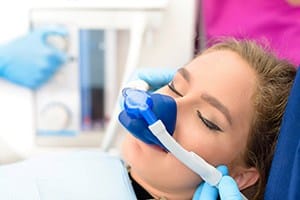
Still, keep in mind that some people aren’t a good fit for nitrous oxide. Someone pregnant, for example, may want to avoid it for fear of affecting the unborn child. Meanwhile, those with sinus congestion or respiratory disease might find nitrous oxide ineffective. After all, their poor health may prevent them from inhaling the gas properly.
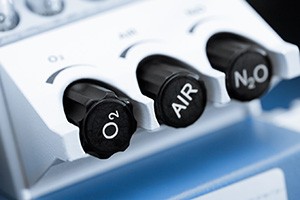
How Does Nitrous Oxide Dental Sedation Work?
Overall, it isn’t too hard to apply nitrous oxide. Arranging the setup, in fact, only takes a few minutes or so. The dentist is then free to perform their work with a relaxed patient.
For this sedation, you inhale nitrous oxide – before and during treatment – through a nose mask.
That way, you’ll be sedated when the dentist starts working. Staff will also monitor your vitals to ensure safety while applying the gas.
Nitrous oxide “kicks in” about a minute or two after inhaling it. At that point, you’ll begin to experience light-headedness and mild euphoria. Your limbs may also seem tingly or heavier than usual. Regardless of the specifics, though, you can expect to feel calm and comfortable as it works. However, the gas won’t put you to sleep; you’ll be alert and lucid enough to answer the dentist’s questions or instructions.
Aftercare for Nitrous Oxide Dental Sedation
Ultimately, nitrous oxide sedation doesn’t require much aftercare. Its effects quickly fade once you stop inhaling it. That said, there are a few things you should know beforehand.
First, nitrous oxide takes a few minutes to exit your body. You should thus wait at our office until you feel normal before driving. Doing otherwise could put you at risk of an accident.

Secondly, the sedative won’t have any long-term effects. After the initial waiting period, you’ll be well enough to return to your regular routines – work, school, or any other task.
Lastly, follow any treatment-specific recovery instructions from your dentist. These guidelines will ease sedation effects more quickly.

Oral Conscious Dental Sedation
Oral conscious sedation creates a deeper level of relaxation than can be achieved through nitrous oxide alone. A sedative medication is taken by mouth about an hour before treatment. Oral sedation may be used in combination with nitrous oxide. This will increase the level of relaxation. Taking a sedative tablet works well for patients who can normally cope with dental treatment. Patients experience a drowsy sensation, but remain awake and able to respond to questions and requests throughout their treatment. Oral conscious sedation works well for patients who appreciate the quicker passage of time. Because of this, treatment is completed in a more pleasant way.
Sedation Dentistry FAQs
Are you thinking of seeing your sedation dentist? If so, that’s great news to hear! We at Roman Dental use sedatives that make treatment truly smooth and comfortable. That said, you might have questions about how the process works. After all, you likely want to ensure sedation is your ideal choice. Therefore, listed below are the answers to some frequently asked sedation questions. Please read them over to get a better feel for dental sedatives. If you don’t find the facts you want, though, don’t worry — feel free to call our office or set up a visit for more details!
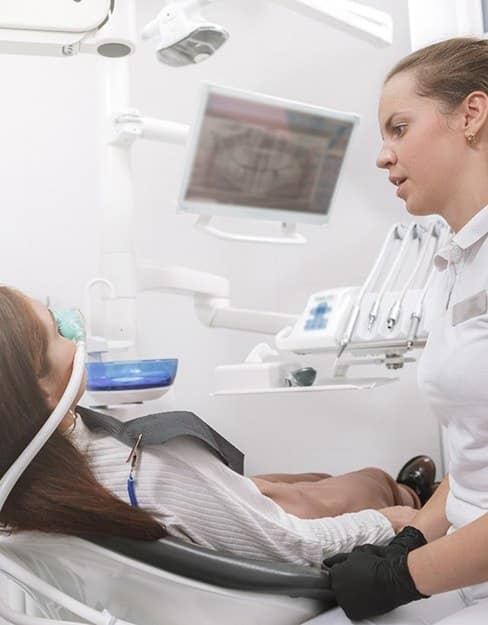
Rest assured, sedation dentistry is generally safe for most patients. Still, it does present risks for some people.
In general, dental sedatives are only risky if you’re in a unique situation. For example, those with sleep apnea or who take certain medications may develop complications from them. Furthermore, some patients have unique bodies that might react differently to the sedation process.
Again, we emphasize that dental sedatives are usually safe. At most, their typical side effects are nausea, headaches, or grogginess — things that don’t harm your long-term health.
Whatever else you feel from sedation, it’s a certainty that you won’t experience pain. All available types ensure your procedure isn’t uncomfortable.
You see, all our sedatives numb your body to discomfort. Whether it’s oral conscious, nitrous oxide, or IV dental sedation, you won’t feel a thing. You’ll still be awake, though, so you may experience some pressure rather than outright pain.
We might also use a local anesthetic to prevent pain, depending on the procedure.
Again, you’re technically awake for most forms of sedation. However, there’s a good chance you won’t remember much of your procedure.
Among other things, one (temporary) effect of sedatives is reduced memory formation. The medicines put you in a dream-like haze, making it harder to form memories. IV sedation, especially, is likely to make you forget your procedure. Fortunately, this memory-loss effect makes dental care much easier for patients with anxiety or negative past dental experiences.
How much your sedation costs will vary based on the kind you get.
In general, IV sedation and general anesthesia cost more than nitrous oxide or oral conscious sedation. The former two require more training to administer; they also involve more risks. In contrast, nitrous oxide and oral conscious sedation only cost a few hundred dollars.
Another factor to consider is time. A sedative service’s price often depends on how long you’re under its effects.
Still, you can get affordable sedation dentistry with our help. Roman Dental offers flexible financing through CareCredit, allowing patients to cover treatment with low-interest, monthly payments. That way, you can manage the costs over time instead of all at once.








